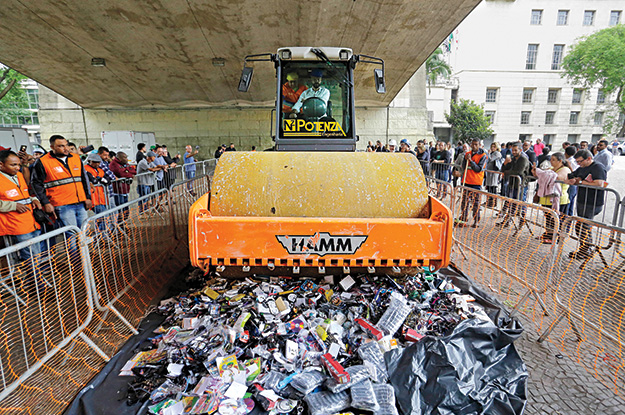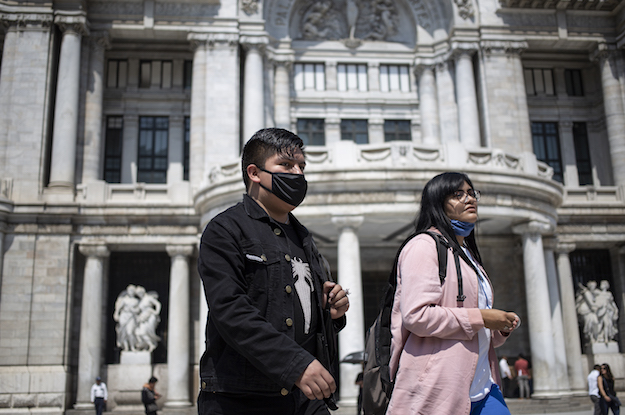This article is adapted from AQ’s print issue on piracy
All Latin American countries face the challenge of combating piracy — but some do a better job than others.
Here, AQ looks at what six particular governments are doing, and the challenges they still face. One common thread: While laws on the books are strong in many countries, it’s the enforcement that varies widely.
We have also included where these countries stand in the government policy indicator of the Global Illicit Trade Environment Index (GITEI), compiled by the Economist Intelligence Unit and the Transnational Alliance to Combat Illicit Trade. It ranks 84 economies on intellectual property (IP) protections and policies to prevent illicit trade.
Note: PPH refers to a Patent Prosecution Highway, a mechanism that makes it easier for countries to coordinate IP protection.
Brazil
What’s Happening: Brazil borders 10 countries and has 4,700 miles of coastline, providing multiple points of entry for counterfeit goods. The most notorious area is the Triple Frontier with Paraguay and Argentina. Digital piracy is rampant: 46 percent of software installed in Brazil is unlicensed, and totals a loss of $1.7 billion in commercial value. The public-private National Council on Combating Piracy and Intellectual Property Crimes resumed activity in 2018 but has produced few concrete results.
What the Government Is Doing: Occasional raids shut down counterfeit markets, such as São Paulo’s 25 de março, where approximately 800 tons of goods worth $78 million were seized in 2017. The market reopened two months later. Selling pirated software can carry up to four years in jail and a fine. However, the counterfeiting of pharmaceuticals and alcoholic beverages is subject to up to 15 years’ imprisonment. Brazil is a member of a PPH.
What Are the Challenges?: “Enforcement is really poor in certain states” because of corruption within law enforcement agencies, said José Henrique Vasi Werner, a prominent Brazilian IP lawyer. Free Trade Zones (FTZs), especially those in Manaus and along the Paraguayan and Colombian borders, are major distribution points for counterfeit products, according to Werner. Generally fast internet availability makes it possible and easier to access pirated entertainment options, from movies to subscription television providers.
GITEI Government Policy: 49/84
Colombia
What’s Happening: The port of Buenaventura, as well as the cities of Bogotá, Medellín and Cali, are major hubs of counterfeit trade, according to Juan Pablo Concha Delgado, partner at Baker & McKenzie in Bogotá. Piracy in the digital arena is widespread — 48 percent of software in Colombia is unlicensed. According to the Global Innovation Center at the U.S. Chamber of Commerce, the IP environment for protecting biopharmaceuticals has become especially difficult over the past two years.
What the Government Is Doing: As a member of the Andean Community, Colombia has an IP law dating from 2000 that also applies to Ecuador, Bolivia and Peru. In 2016, customs agents were granted greater authority to seize suspected counterfeit goods. An updated police code from January 2017 included new IP provisions. Colombia is a member of two pphs.
What Are the Challenges?: Colombia was placed on the Office of the U.S. Trade Representative 2018 Priority Watch List for failing to implement IP provisions in the 2012 United States-Colombia Trade Promotion Agreement. Surging cocaine production has also exacerbated the counterfeit problem. Cocaine smugglers are increasingly trading in counterfeit goods and contraband to avoid laundering large quantities of cash, noted Concha Delgado.
GITEI Government Policy: 36/84
Mexico
What’s Happening: Piracy and trade in counterfeit goods remain widespread, according to the Office of the U.S. Trade Representative, which also points to weak border enforcement. However, free trade agreements promise to update IP protections. Carlos Dávila Peniche, senior associate at Baker & McKenzie, noted that the IP provisions in the USMCA are upgraded from those in NAFTA and observed that negotiators are “trying to close the gap that existed for the digital environment.”
What the Government Is Doing: Mexico’s IP laws date from 1994. “The digital arena is not duly protected,” noted Roberto Arochi, partner at Arochi & Lindner. The Office of the U.S. Trade Representative observes that the Mexican Attorney General’s Office will not authorize seizures of in-transit suspected counterfeit goods unless it determines the impact of those goods on the Mexican economy. Mexico is a member of a PPH.
What Are the Challenges?: Trade in counterfeit goods is especially active along the porous border with Belize and in its Corozal Free Trade Zone. President Andrés Manuel López Obrador plans to open Mexico’s first FTZs along its northern and southern borders. “FTZs have an economic appeal to bolster specific zones,” but the push to increase the number “entails a risk to IP rights and creates an embedded risk of counterfeit and piracy,” according to Dávila Peniche.
GITEI Government Policy: 48/84
Panama
What’s Happening: With three major ports on the Atlantic and two on the Pacific, as well as the Panama Canal and the Colón Free Zone, Panama sees a high volume of trade. An analysis from Icaza, González-Ruiz & Alemán found that in 2016, the value of counterfeit goods seized at Panamanian container ports reached $21 million. All of those goods originated in China. According to the U.S. State Department, Panama “has an adequate and effective domestic legal framework to protect and enforce intellectual property rights.”
What the Government Is Doing: Panama was the first Latin American country to give power to customs authorities to seize counterfeit goods in transit without a court order. A specialized IP prosecutor’s office frequently carries out raids. The destruction of counterfeit goods is expedited to approximately three months after seizures. Trading in counterfeits carries a prison sentence of four to six years. Panama is a member of a PPH.
What Are the Challenges?: In June 2017, Panama switched its diplomatic allegiance from Taiwan to China, which is affecting IP provisions in its negotiations with China over a free trade agreement. IP attorney Hugo Morán was present at the trade talks and observed that “Panama imposed the IP chapter because China was not willing to implement it.” The Colón Free Zone, the largest and oldest FTZ in Latin America, continues to be a key distribution point for counterfeit goods in the region.
GITEI Government Policy: 52/84
Paraguay
What’s Happening: Ciudad del Este is a hub for organized crime and pirated goods. Located in the Triple Frontier area bordering Brazil and Argentina, the city attracts mainly Brazilian customers. The Office of the U.S. Trade Representative has kept Ciudad del Este on its list of “notorious markets” for 15 years. The U.S. State Department highlights inadequate protection for agrochemical and pharmaceutical products and stresses the unenforceability of the current patent law.
What the Government Is Doing: Paraguay has a specialized prosecutor that only deals with IP protection issues. The National Directorate of Intellectual Property, created in 2012, coordinates IP policy. Since 2013, authorities have seized $300 million worth of counterfeit goods. Paraguay is a member of a PPH.
What Are the Challenges?: A specialist in IP and partner in a law firm that bears her name, Virginia Cervieri noted that Paraguay’s main challenge is to “increase the number of seizures of containers with counterfeit products that enter the country.” Digital piracy rates also remain high — 83 percent of software in Paraguay is unlicensed, a rate that within Latin America is surpassed only by Venezuela.
GITEI Government Policy: 70/84
Uruguay
What’s Happening: Uruguay is strategically located and serves as a major transit point for goods heading to landlocked Paraguay and Bolivia. “Uruguay is an in-transit country” where “90 percent of the merchandise we seize is not coming to Uruguay,” noted Cervieri. The U.S. State Department observes that IP protection and enforcement have steadily improved in recent years.
What the Government Is Doing: A 2015 decree permits customs to operate inside Uruguay’s 13 FTZs and fine the owners and distributors of counterfeit products. The customs authority promotes transparency by publishing regularly updated reports on the type and value of seized counterfeit goods. Customs agents are authorized to seize merchandise in transit. Uruguay is a member of a PPH.
What Are the Challenges?: While customs authorities in Uruguay have more power to seize suspected counterfeit goods than in other Latin American countries, Uruguay lacks judges and prosecutors specialized in IP. “One of the most important challenges that Uruguay faces in order to continue improving in the fight against counterfeiting is to advance toward specialized justice in intellectual property matters,” observed Cervieri.
GITEI Government Policy: 21/84
—
Sweigart is a policy consultant at AQ








